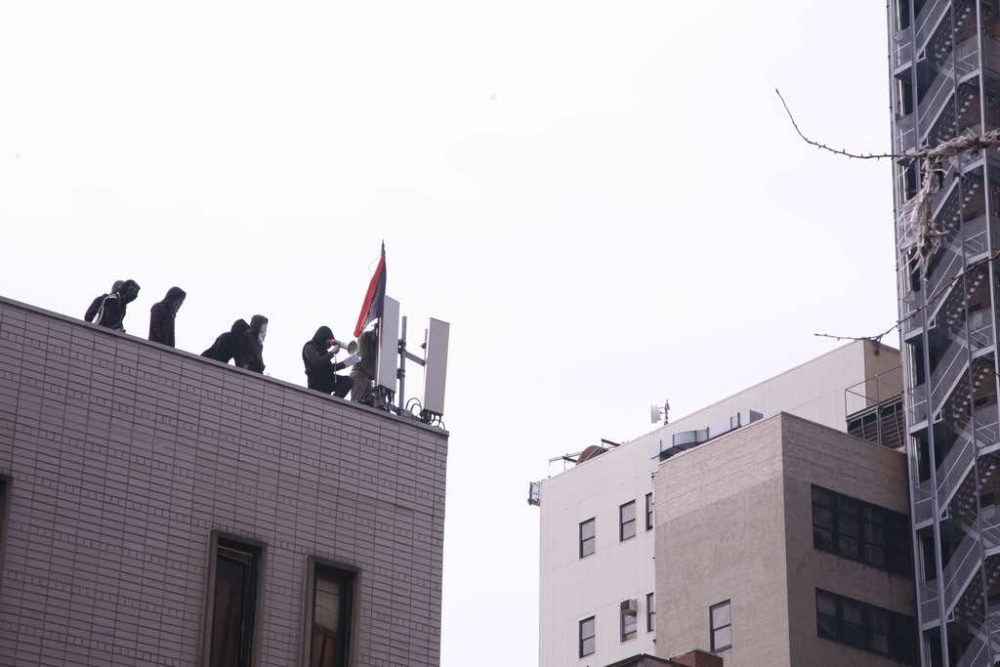
From CrimethInc.
A wave of campus building occupations took place in response to austerity measures following the recession of 2008. As today’s Gaza solidarity movement begins to experiment with encampments and building occupations, it could be instructive to learn from the previous generation of student activists.
On April 22, 2024, inspired by the resilience of the Gaza solidarity encampment at Columbia University and other demonstrators around the country, students at Cal Poly Humboldt in Arcata, California occupied Siemens Hall. This represented the first confrontational building occupation of a wave of student demonstrations in solidarity with Palestine.
Police attempted to storm Siemens Hall in order to evict it; they inflicted severe injuries on some students, but failed to gain entry. The officers established a perimeter around the building, but students and university faculty gathered around them, surrounding them and chanting “De-escalate by leaving!” In the end, local media reported that the police were forced to withdraw:
10:50 pm: All law enforcement have left from in front of the building and appear to be leaving the campus. Scanner traffic appears to confirm that law enforcement has left the scene. One officer said that law enforcement is being “disbanded.” Students are currently pouring in and out of the occupied building.
“Cops go home!” the students chanted victoriously. “People power! We are stronger!”
Taking over a building and forcing the police off campus is no mean feat in the age of police militarization. Yet this is not the first time this century that student movements have employed these tactics. From December 2008 to March 2010, a wave of student building occupations helped to spark a new era of combative grassroots struggle. Starting with only a few participants, these building occupations eventually helped to inspire the Occupy movement, which catalyzed tens of thousands of people into action.
The following text chronicles the emergence of this wave of building occupations from the perspective of those who helped start it, first in New York and then in California. This article originally appeared in issue 9 of Rolling Thunder, our Anarchist Journal of Dangerous Living. It appears here with a handful of modifications reflecting the decade and a half that has passed since.

Coast to Coast Occupations
“The coming occupations will have no end in sight, and no means to resolve them. When that happens, we will finally be ready to abandon them.”
This is How We Learn, This is How We Fight
By a participant in the occupations in New York City of 2008-2009.
In December 2008, the month of the Greek rebellion, the widely hated president of New York City’s New School for Social Research fired the Provost and appointed himself. He also cut the library in half, shut down a building where students gathered, and raised tuition. When the Faculty came out with a vote of no confidence in him on December 10, previously apathetic students joined those trained by summit battles to take action. Standard campus activist SDS [Students for a Democratic Society] groups wanted to wait for the right time—”the movement is not ready,” “we need more numbers.” We thought otherwise.
After two grueling meetings, on December 16 at 8 pm, thirty students and non-students took the first floor of 65 5th Avenue, in the middle of Manhattan, blocking the exits with chairs, tables, and trash cans from the cafeteria. Within hours, hundreds of people came out in support, and students who until then had only read Hegel were fighting security guards with tables and blocking the streets outside. This lasted from Wednesday night to Friday morning. Authoritarian groups issued demands while autonomous groups conspired to bring in more people and expand the occupation. At key moments, against the formal consensus of some, friends outside were broken in with spectacular actions. A Greek solidarity march came by and livened up the party with a hundred more anarchists. The president was chased down the street to his home, and conceded to some of the demands soon after. We left with no repercussions, but bitter that the university still functioned at all.


